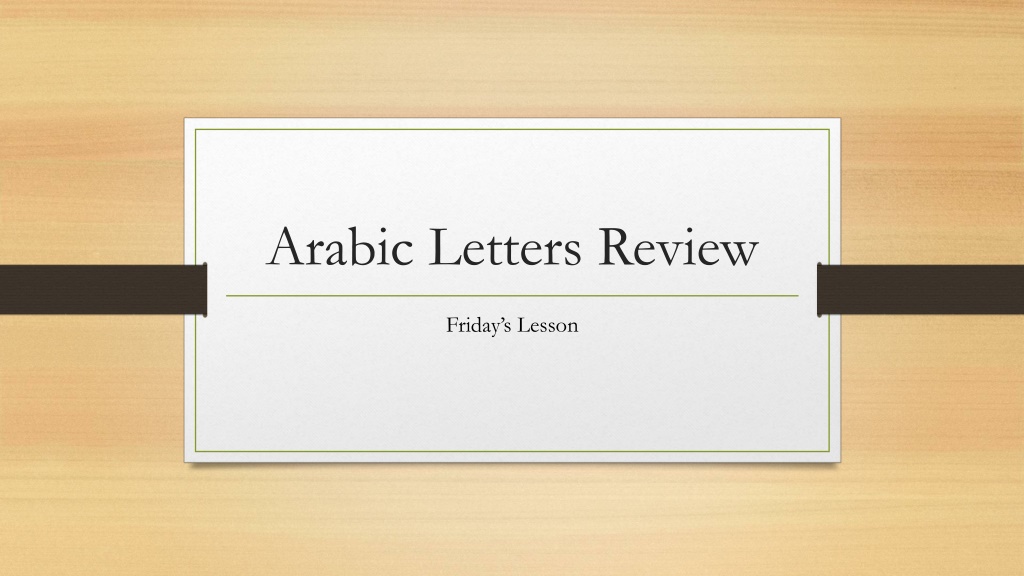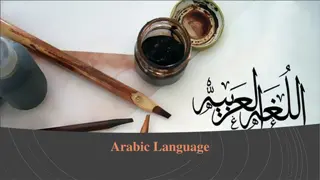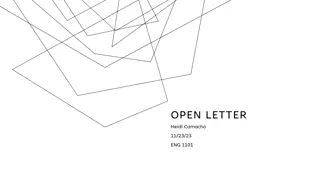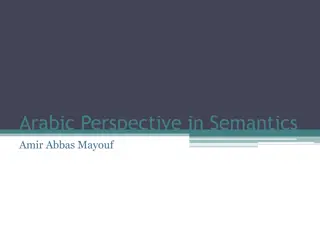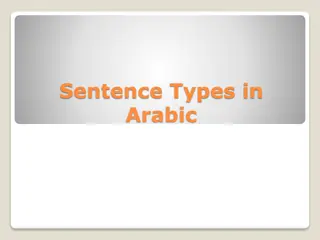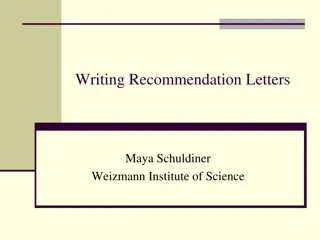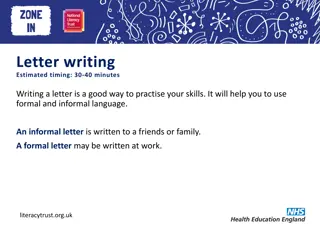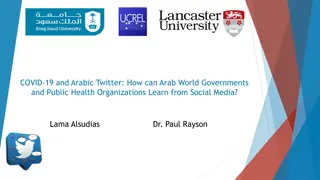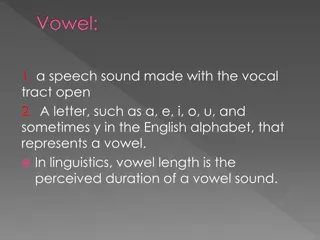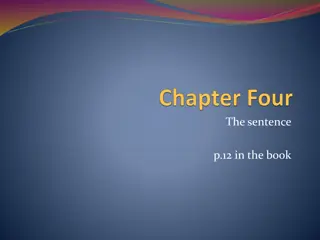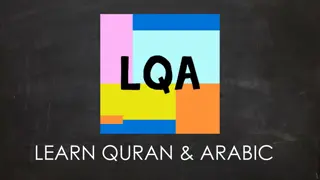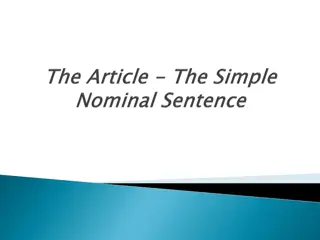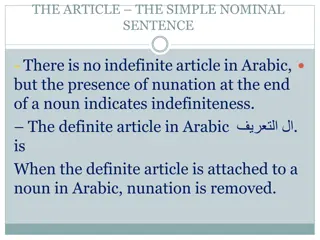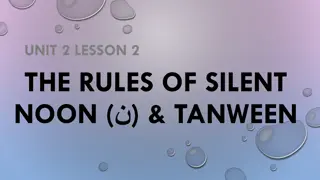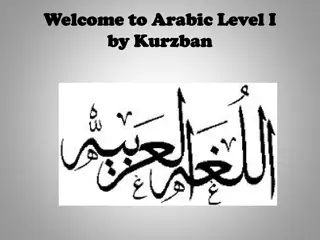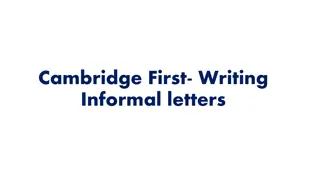Arabic Letters Review & Writing Tips for Beginners
Enhance your Arabic handwriting skills with this comprehensive guide featuring pronunciation tips and detailed instructions on writing Arabic letters. Explore the unique characteristics of one-way and two-way connectors, and learn how to write letters like Zay, Waw, Thal, Del, Alif, and Ra. Perfect your Arabic script and master the art of forming letters correctly in this engaging lesson.
Download Presentation

Please find below an Image/Link to download the presentation.
The content on the website is provided AS IS for your information and personal use only. It may not be sold, licensed, or shared on other websites without obtaining consent from the author.If you encounter any issues during the download, it is possible that the publisher has removed the file from their server.
You are allowed to download the files provided on this website for personal or commercial use, subject to the condition that they are used lawfully. All files are the property of their respective owners.
The content on the website is provided AS IS for your information and personal use only. It may not be sold, licensed, or shared on other websites without obtaining consent from the author.
E N D
Presentation Transcript
Arabic Letters Review Friday s Lesson
One Way Connectors Letters that can only be connected from one direction while being written.
Pronounced as the S in the word busy This letter starts above the line, but curves underneath the line. English pronunciation is Zay How to write your Zay: Initial: Medial_______ Final connected: Final unconnected:
Pronounced as the w sound in wet or the oo sound in boot Starts above the line, but curves underneath the line. English pronunciation is Waw. How to write your Waw: Initial: Medial: ______Final connected: Final unconnected:
Pronounced as the th in then Stays above the line at all times English pronunciation Thal How to write your Thal: Initial: Medial: Final connected: Final unconnected:
Pronounced as the d in dim or in donkey Stays above the line at all times English pronunciation Del How to write your Del: Initial: Medial: Final connected: Final unconnected:
Pronounced as the a in dad and far Stays above the line at all times English pronunciation is Alif How to write your Alif Initial: Medial: * Final connected: Final unconnected: *when connected the Alif acts as a long vowel sound for an a.
Pronounced as the r in thrilled and rolled Starts above the line, but curves underneath the line. English pronunciation is Ra How to write your Ra Initial: Medial: Final connected: Final unconnected: * *the second Ra is just used as a filler letter to go infront of the letters when they are a final unconnected.
Two Way Connectors These are letters that can be connected from both directions.
Pronounced as the b in ball Stays above the line at all times English pronunciation is Ba How to write your Ba Initial: Medial: Final connected: Final unconnected:
Pronounced as the t in trouble Stays above the line at all times English pronunciation is Ta How to write you Ta: Initial: Medial: Final connected: Final unconnected:
Pronounced as the th in thin Stays above the line at all times English pronunciation is Tha How to write your Tha Initial: Medial: Final connected: Final unconnected:
Pronounced as the n in nine Starts above the line, but briefly dips under, then comes back up over the line again, unless it is in an initial or medial placement, in which case it would remain above the line completely English pronunciation is Nun How to write your Nun: Initial: Medial: Final connected: Final unconnected:
Pronounced as the y in yellow Starts above the line as the tail curls under the head and back out behind it, but ends still underneath the line, unless it is in an initial or medial position, in which case it would remain completely above the line. English pronunciation is Ya How to write your Ya: Initial: Medial: Final connected: Final unconnected:
Pronounced as the s in seen While in an initial or medial placement the tail disappears and only the part that looks like a w is seen, but when unconnected or as a final letter, the tail is kept and dips below the line and comes back up. English pronunciation is Sin How to write your Sin Initial: Medial: Final connected: Final unconnected:
Pronounced as the sh in sheep While in an initial or medial placement the tail disappears and only the part that looks like a w is seen, but when unconnected or as a final letter, the tail is kept and dips below the line and comes back up. English pronunciation is Shin How to write your Shin Initial: Medial: Final connected: Final unconnected:
Pronounced as either the g in Gabe or the j in jean While in an initial and medial placement it stays above the lines at all times, but if in a final or free standing position it will start above the line, but will curve underneath the line and will end there. English pronunciation is jim
Pronounced as a voiceless h sound as in the h in who While in an initial and medial placement it stays above the lines at all times, but if in a final or free standing position it will start above the line, but will curve underneath the line and will end there. English pronunciation is hakim
Pronounced as a hard h sound, coming from the throat as in the ch in challa bread While in an initial and medial placement it stays above the lines at all times, but if in a final or free standing position it will start above the line, but will curve underneath the line and will end there. English pronunciation is kha
, , How to write your When written in the initial or medial placement then they are written as so: When written in a final placement it is written the same behind a one way connector and a two way connector: Be sure not to forget the proper dot placement.
Pronounced as the f in fat Remains above the line at all times English pronunciation is Fa How to write your fa: Initial: Medial: Final connected: Final unconnected:
Pronounced as the q in queen (minus the u part, like a throaty k sound) Starts above the line, but briefly dips under, then comes back up again English pronunciation is Qaf How to write your QafL Initial: Medial: Final connected: Final unconnected:
Ta Marbuta A variant of the , but serving only as a suffix When following a two way connector it is written like so: When following a one way connector it is written as:
Lets practice + + + = = = + + + +
Write an appropriate transliteration to each; respect the vowels.
